

ICD-10 - Centers for Medicare. With enactment of the Protecting Access to Medicare Act of 2014, CMS is examining the implications of the ICD-10 provision and will provide guidance to providers and stakeholders soon.

This provision in the statute reads as follows: “The Secretary of Health and Human Services may not, prior to October 1, 2015, adopt ICD-10 code sets as the standard for codes sets under section 1173 (c) of the Social Security Act (42 U.S.C. 1320d-2 (c)) and section 162.1002 of title 45, Code of Federal Regulations.” Natural language processing: Changing health care - Meaningful Health Care Informatics Blog. Feb 18 2013 10:22PM GMT Posted by: RedaChouffani EHR, information extraction, NLP, text analysis, text parsing An area of computer science long studied by university graduates and professors is becoming one of the leading informational technologies: natural language processing.
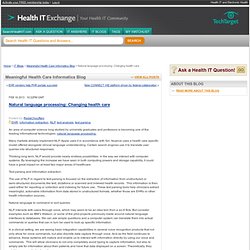
Many markets already implement NLP. Apple uses it in accordance with Siri. Thinking long term, NLP would provide nearly endless possibilities in the way we interact with computer systems. What is computer assisted coding system (CACS)? - Definition from WhatIs.com. ICPC-2e - Helsedirektoratet, avd. standardisering.
Download - Helsedirektoratet, avd. standardisering. The ICPC-2e versions on this page follow the ICPC version numbering system introduced by the WICC Update Group in November 2005.

ICPC-2e-v.4.3 15. September 2013 This updated version has several changes in mapping to ICD-10. This version is published in excel. ICPC-2 PLUS: the BEACH coding system - FMRC. ICPC Primary Health Care Classification Consortium - WICC WONCA. Global Family Doctor - Wonca Online. Prof Michael Klinkman (USA) Email Chair Prof Michael Klinkman MD MS, is a Michigan native who has spent most of his life serving the people of his home state.
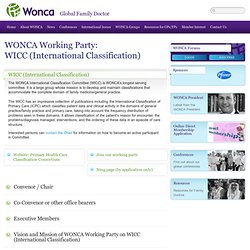
Gutteridge: SNOMED is 'too hard' SNOMED text-parser UI jamesfone74 weeks ago Aside from; form input, multi-parent 'tree' browsing, and the usual single concept matching searches, the Common User Interface team spent some time investigating the 'text parser' approach to SNOMED coding.
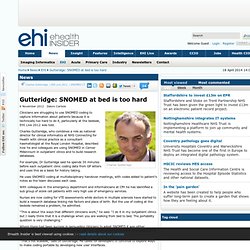
In particular a setup where the parser runs in real-time on the narrative, flags up codable terms, then the author confirms these, leaves them uncoded, or edits the term suggested (just like a spell checker). The designs are publically available at The matching achieved by the prototype (not accessible anymore) was pretty good and a lot of the time the top match would be a good fit. Supporting Information: A&E Diagnosis Tables. Anatomical Therapeutic Chemical Classification System. The Anatomical Therapeutic Chemical (ATC) Classification System is used for the classification of drugs.
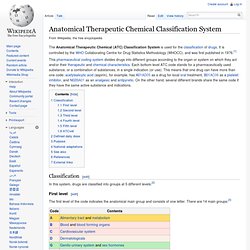
It is controlled by the WHO Collaborating Centre for Drug Statistics Methodology (WHOCC), and was first published in 1976.[1] This pharmaceutical coding system divides drugs into different groups according to the organ or system on which they act and/or their therapeutic and chemical characteristics. Each bottom-level ATC code stands for a pharmaceutically used substance, or a combination of substances, in a single indication (or use).
This means that one drug can have more than one code: acetylsalicylic acid (aspirin), for example, has A01AD05 as a drug for local oral treatment, B01AC06 as a platelet inhibitor, and N02BA01 as an analgesic and antipyretic. On the other hand, several different brands share the same code if they have the same active substance and indications. Classification[edit] In this system, drugs are classified into groups at 5 different levels:[2] Using ontology-based annotation to profile disease research. WebProtégé. Icdplus4.com. The Protégé Ontology Editor and Knowledge Acquisition System. TIST: Current Issue.
Network Visualisation. Lingua franca critical for electronic medical records and health information exchange. Public release date: 22-Dec-2011 [ Print | E-mail Share ] [ Close Window ] Contact: Cindy Fox Aisencaisen@iupui.edu 317-274-7722Indiana University School of Medicine INDIANAPOLIS – A universal method of identifying medical test results and other clinical measurements is essential for health information exchange, which requires a common terminology to ensure that medical data can be recorded, transferred and ultimately used when and where the patient needs it.
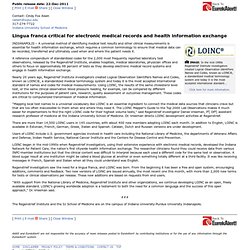
A reference compendium of standardized codes for the 2,000 most frequently reported laboratory test observations, released by the Regenstrief Institute, enables hospitals, medical laboratories, physician offices and others to focus on approximately 98 percent of tests as they develop electronic medical record systems and engage in health information exchange. There are more than 14,500 LOINC users in 145 countries, with about 400 new members adopting LOINC each month. Natl Center for Biomedical Ontology. Journal of the American Medical Informatics Associationjamia.bmj.com 2012;19:190-195 doi:10.1136/amiajnl-2011-000523 Brief communication + Author Affiliations Correspondence to Dr Mark A Musen, Biomedical Informatics Research, Stanford University, 251 Campus Drive, Stanford, CA 94305-5479, USA; musen@stanford.edu Received 3 August 2011 Accepted 15 August 2011 Published Online First 10 November 2011.
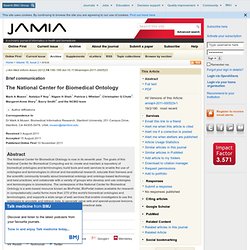
Logical Observation Identifiers Names and Codes (LOINC®) — LOINC. Assessing validity of ICD-9-CM and ICD-10 administrative data in recording clinical conditions in a unique dually coded database.(Methods) - Health Services Research. HCUP-US Tools & Software Page. Semantic tools. Dave Beckett's Resource Description Framework (RDF) Resource Guide. Diagnosis-Related Groups in Europe: Moving towards transparency, efficiency and quality in hospitals - Reinhard Busse,Alexander Geissler,Wilm Quentin,Miriam Wiley - McGraw-Hill Education.
Reinhard Busse is Professor and Head of the Department of Healthcare Management at Berlin University of Technology, Germany.

Alexander Geissler is a research fellow in the Department of Health Care Management at Berlin University of Technology, Germany. Wilm Quentin is a research fellow in the Department of Health Care Management at Berlin University of Technology, Germany. Miriam M. Wiley is Professor and Head of the Health Research and Information Division at the Economic and Social Research Institute in Dublin, Ireland.
VIVO Mini-Grant: Integrating the UMLS Ontology into VIVO for Linkin... Research Interest Mapper. Occupational Health Logic Free + Shareware. From time to time we will add downloadable programs, as well as other tools, which may be of some interest or usefulness (time permitting).
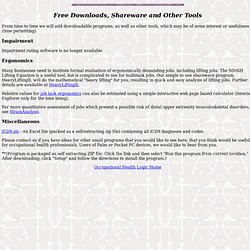
Impairment Impairment rating software is no longer available. Ergonomics Many businesses need to institute formal evaluation of ergonomically demanding jobs, including lifting jobs. The NIOSH Lifting Equation is a useful tool, but is complicated to use for multitask jobs. Relative values for job task ergonomics can also be estimated using a simple interactive web page based calculator (Internet Explorer only for the time being). OntologySummit2007 Survey/ResponseAnalysis. Term Ontology Comments Business Rule Design In the late 1980's I had a hard time teaching Business Strategy, MIS, Expert Systems and Policy Audit classes to MBA students.
My sense is that with all of the conceptual mapping tools, and the evolving ontology development/editing tools today, the problem of educating/exposing executives to ontology based policy would be much easier. OntologWiki: ConferenceCall 2007 06 21/SurveySummary. TIST: Current Issue. Transactions on Intelligent Systems and Technology (TIST) Nodus Labs. Identifying the Pathways for Meaning Circulation using Text Network Analysis. By Dmitry Paranyushkin, Nodus Labs. Published October 2011, Berlin. Abstract: In this work we propose a method and algorithm for identifying the pathways for meaning circulation within a text. This is done by visualizing normalized textual data as a graph and deriving the key metrics for the concepts and for the text as a whole using network analysis. The resulting data and graph representation are then used to detect the key concepts, which function as junctions for meaning circulation within a text, contextual clusters comprised of word communities (themes), as well as the most often used pathways for meaning circulation.